Report on Communication and Decision Making for ABC Ltd Business
VerifiedAdded on 2020/02/14
|17
|5602
|72
Report
AI Summary
This report provides a comprehensive analysis of communication and decision-making processes for ABC Ltd, a new start-up company in the food supply industry. The report is divided into four tasks, each addressing critical aspects of business development. Task 1 focuses on the range of decisions to be taken, the information required, and sources of internal and external information, offering recommendations for effective decision-making. Task 2 explores stakeholder relationships, methods for developing these relationships, and plans for involving stakeholders in the decision-making process, alongside future strategies. Task 3 examines the existing communication processes, identifies areas for improvement, and compares different communication methods, with plans for enhancements. Finally, Task 4 addresses access to information systems, and ways to improve them. The report highlights the importance of effective communication in managing a new business, planning expansion, and building strong relationships with stakeholders to ensure success in a competitive market.
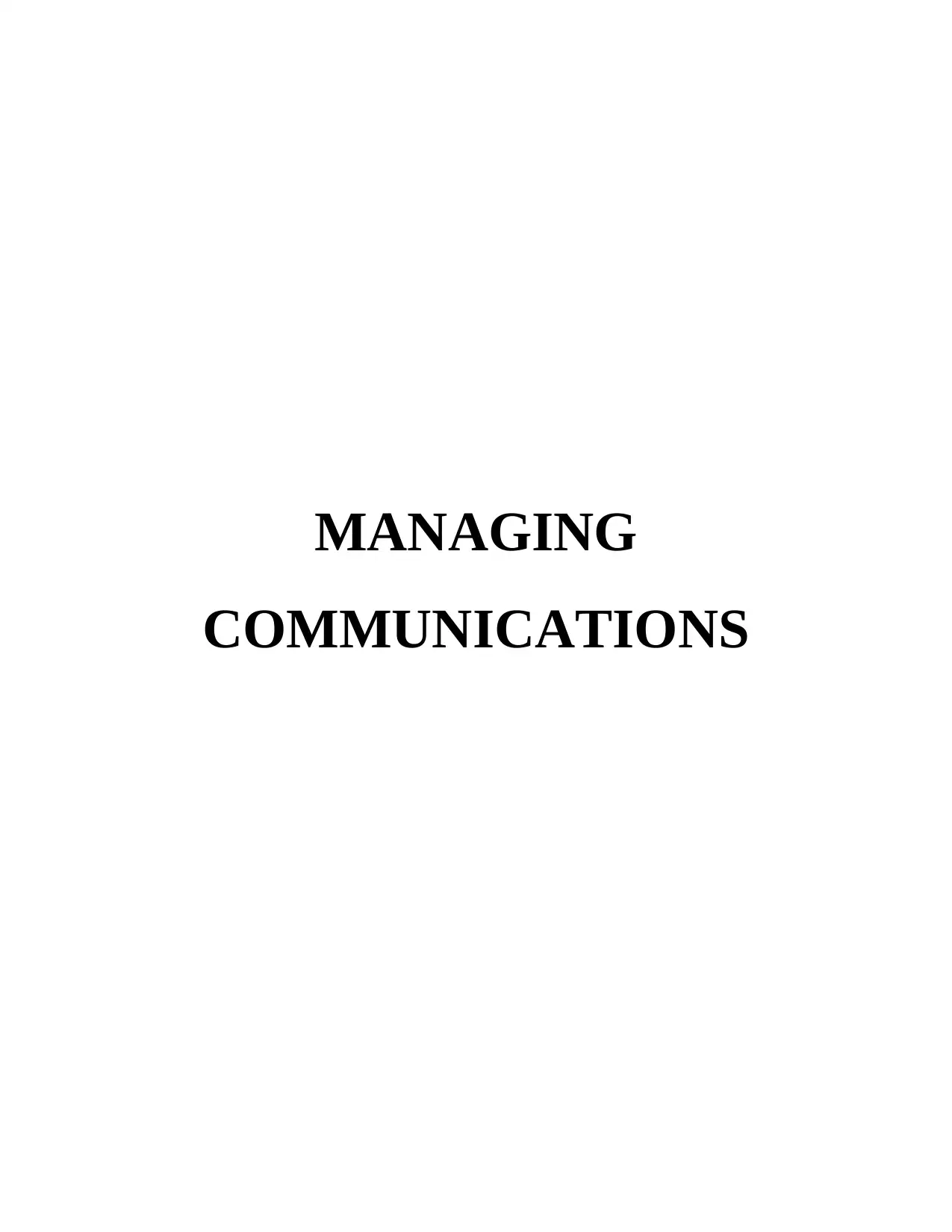
MANAGING
COMMUNICATIONS
COMMUNICATIONS
Paraphrase This Document
Need a fresh take? Get an instant paraphrase of this document with our AI Paraphraser
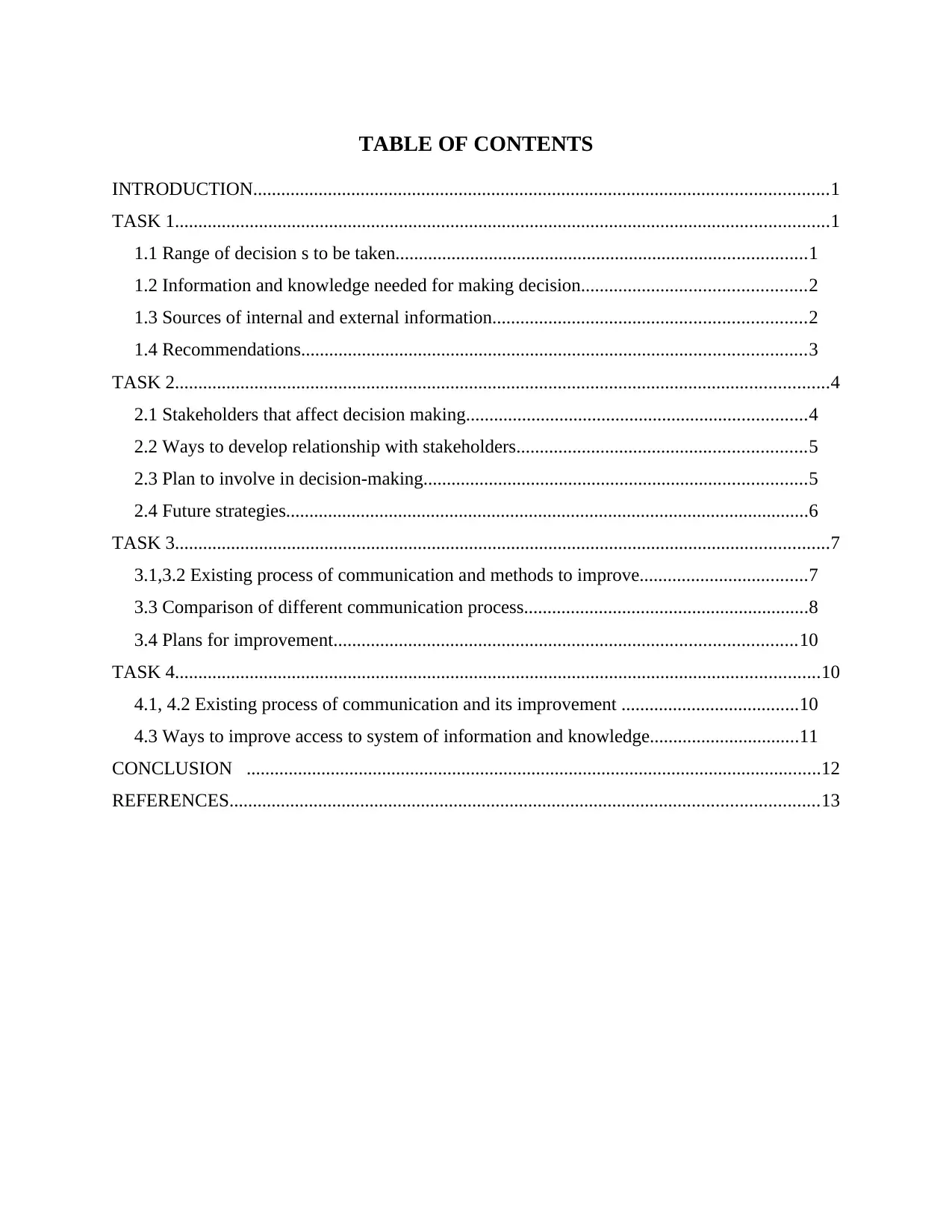
TABLE OF CONTENTS
INTRODUCTION...........................................................................................................................1
TASK 1............................................................................................................................................1
1.1 Range of decision s to be taken........................................................................................1
1.2 Information and knowledge needed for making decision................................................2
1.3 Sources of internal and external information...................................................................2
1.4 Recommendations............................................................................................................3
TASK 2............................................................................................................................................4
2.1 Stakeholders that affect decision making.........................................................................4
2.2 Ways to develop relationship with stakeholders..............................................................5
2.3 Plan to involve in decision-making..................................................................................5
2.4 Future strategies................................................................................................................6
TASK 3............................................................................................................................................7
3.1,3.2 Existing process of communication and methods to improve....................................7
3.3 Comparison of different communication process.............................................................8
3.4 Plans for improvement...................................................................................................10
TASK 4..........................................................................................................................................10
4.1, 4.2 Existing process of communication and its improvement ......................................10
4.3 Ways to improve access to system of information and knowledge................................11
CONCLUSION ...........................................................................................................................12
REFERENCES..............................................................................................................................13
INTRODUCTION...........................................................................................................................1
TASK 1............................................................................................................................................1
1.1 Range of decision s to be taken........................................................................................1
1.2 Information and knowledge needed for making decision................................................2
1.3 Sources of internal and external information...................................................................2
1.4 Recommendations............................................................................................................3
TASK 2............................................................................................................................................4
2.1 Stakeholders that affect decision making.........................................................................4
2.2 Ways to develop relationship with stakeholders..............................................................5
2.3 Plan to involve in decision-making..................................................................................5
2.4 Future strategies................................................................................................................6
TASK 3............................................................................................................................................7
3.1,3.2 Existing process of communication and methods to improve....................................7
3.3 Comparison of different communication process.............................................................8
3.4 Plans for improvement...................................................................................................10
TASK 4..........................................................................................................................................10
4.1, 4.2 Existing process of communication and its improvement ......................................10
4.3 Ways to improve access to system of information and knowledge................................11
CONCLUSION ...........................................................................................................................12
REFERENCES..............................................................................................................................13

⊘ This is a preview!⊘
Do you want full access?
Subscribe today to unlock all pages.

Trusted by 1+ million students worldwide
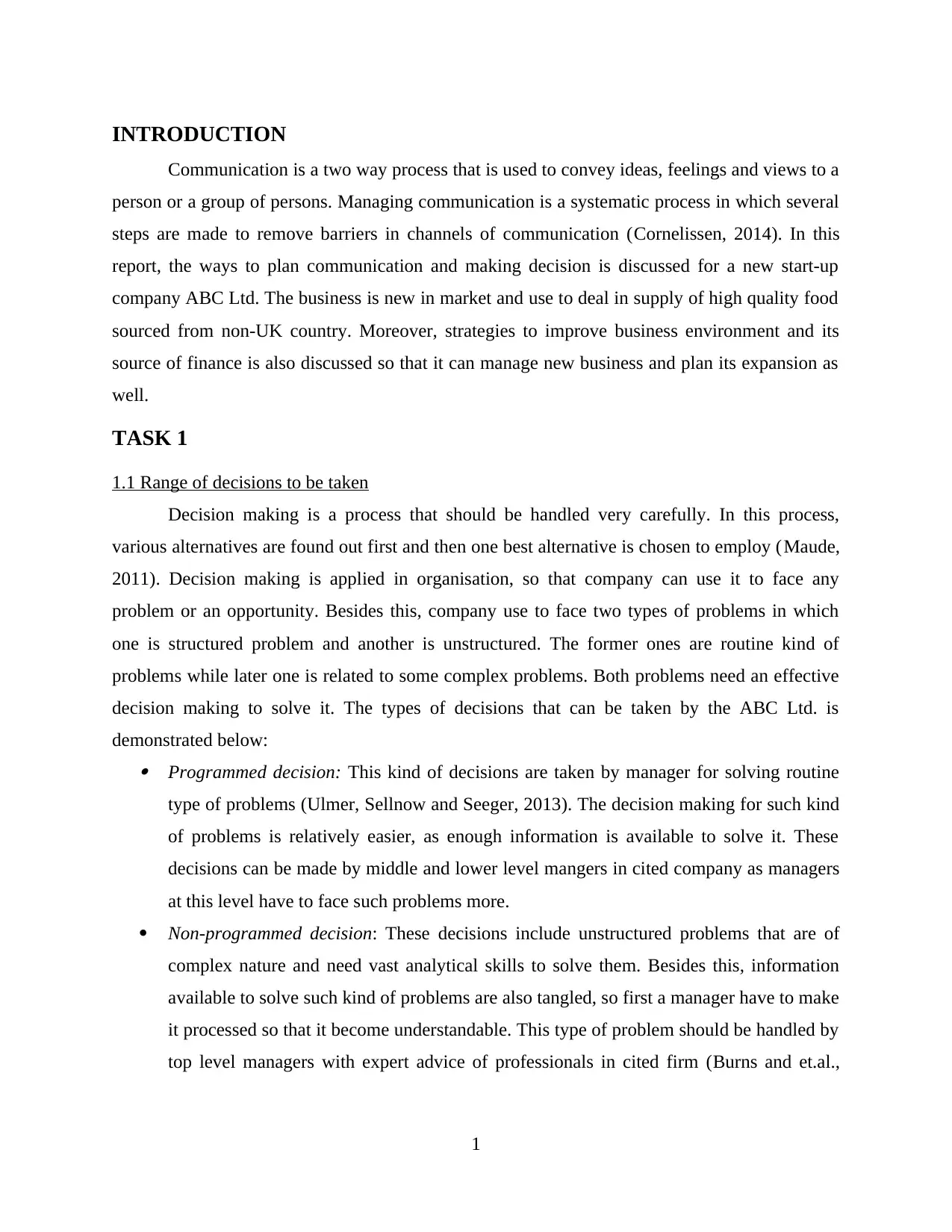
INTRODUCTION
Communication is a two way process that is used to convey ideas, feelings and views to a
person or a group of persons. Managing communication is a systematic process in which several
steps are made to remove barriers in channels of communication (Cornelissen, 2014). In this
report, the ways to plan communication and making decision is discussed for a new start-up
company ABC Ltd. The business is new in market and use to deal in supply of high quality food
sourced from non-UK country. Moreover, strategies to improve business environment and its
source of finance is also discussed so that it can manage new business and plan its expansion as
well.
TASK 1
1.1 Range of decisions to be taken
Decision making is a process that should be handled very carefully. In this process,
various alternatives are found out first and then one best alternative is chosen to employ (Maude,
2011). Decision making is applied in organisation, so that company can use it to face any
problem or an opportunity. Besides this, company use to face two types of problems in which
one is structured problem and another is unstructured. The former ones are routine kind of
problems while later one is related to some complex problems. Both problems need an effective
decision making to solve it. The types of decisions that can be taken by the ABC Ltd. is
demonstrated below: Programmed decision: This kind of decisions are taken by manager for solving routine
type of problems (Ulmer, Sellnow and Seeger, 2013). The decision making for such kind
of problems is relatively easier, as enough information is available to solve it. These
decisions can be made by middle and lower level mangers in cited company as managers
at this level have to face such problems more.
Non-programmed decision: These decisions include unstructured problems that are of
complex nature and need vast analytical skills to solve them. Besides this, information
available to solve such kind of problems are also tangled, so first a manager have to make
it processed so that it become understandable. This type of problem should be handled by
top level managers with expert advice of professionals in cited firm (Burns and et.al.,
1
Communication is a two way process that is used to convey ideas, feelings and views to a
person or a group of persons. Managing communication is a systematic process in which several
steps are made to remove barriers in channels of communication (Cornelissen, 2014). In this
report, the ways to plan communication and making decision is discussed for a new start-up
company ABC Ltd. The business is new in market and use to deal in supply of high quality food
sourced from non-UK country. Moreover, strategies to improve business environment and its
source of finance is also discussed so that it can manage new business and plan its expansion as
well.
TASK 1
1.1 Range of decisions to be taken
Decision making is a process that should be handled very carefully. In this process,
various alternatives are found out first and then one best alternative is chosen to employ (Maude,
2011). Decision making is applied in organisation, so that company can use it to face any
problem or an opportunity. Besides this, company use to face two types of problems in which
one is structured problem and another is unstructured. The former ones are routine kind of
problems while later one is related to some complex problems. Both problems need an effective
decision making to solve it. The types of decisions that can be taken by the ABC Ltd. is
demonstrated below: Programmed decision: This kind of decisions are taken by manager for solving routine
type of problems (Ulmer, Sellnow and Seeger, 2013). The decision making for such kind
of problems is relatively easier, as enough information is available to solve it. These
decisions can be made by middle and lower level mangers in cited company as managers
at this level have to face such problems more.
Non-programmed decision: These decisions include unstructured problems that are of
complex nature and need vast analytical skills to solve them. Besides this, information
available to solve such kind of problems are also tangled, so first a manager have to make
it processed so that it become understandable. This type of problem should be handled by
top level managers with expert advice of professionals in cited firm (Burns and et.al.,
1
Paraphrase This Document
Need a fresh take? Get an instant paraphrase of this document with our AI Paraphraser
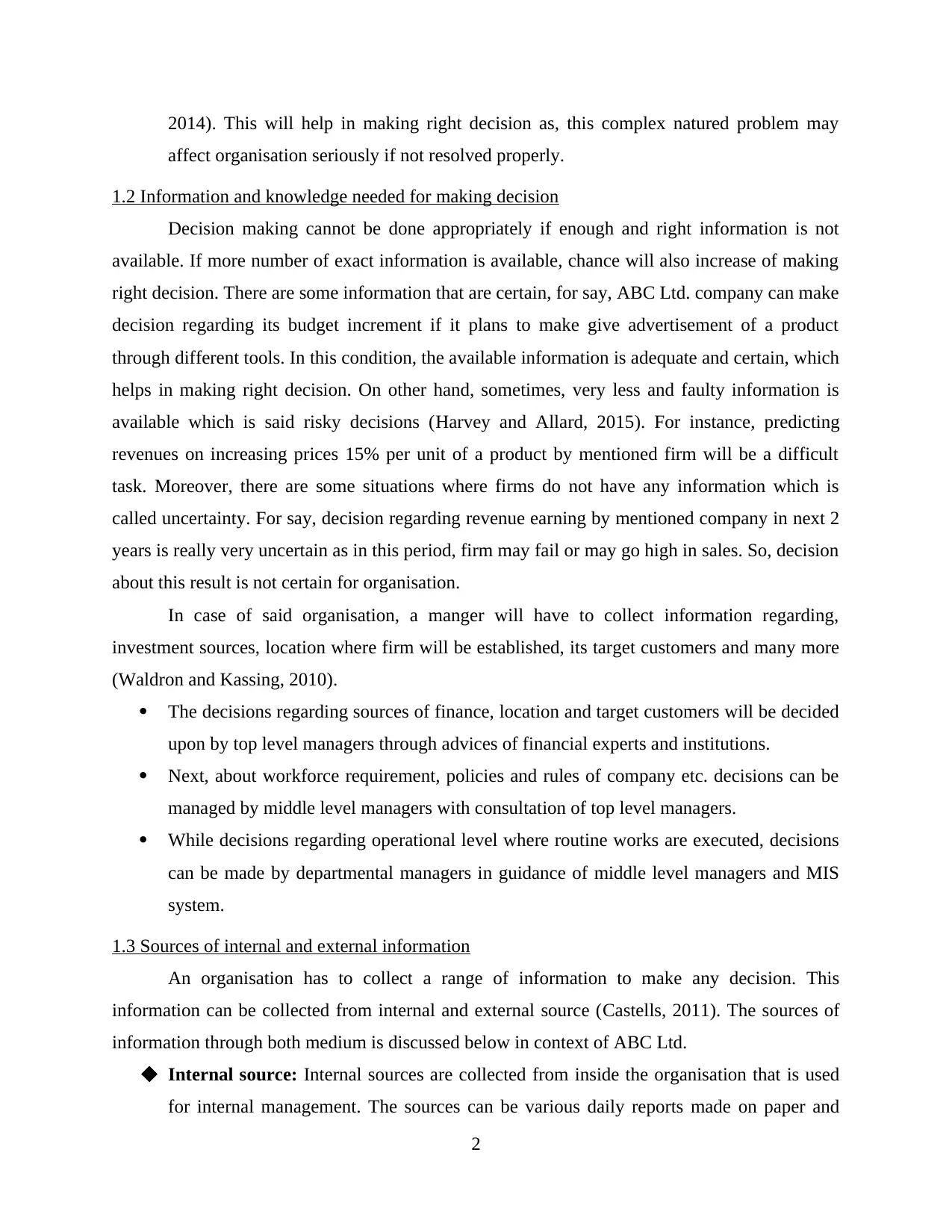
2014). This will help in making right decision as, this complex natured problem may
affect organisation seriously if not resolved properly.
1.2 Information and knowledge needed for making decision
Decision making cannot be done appropriately if enough and right information is not
available. If more number of exact information is available, chance will also increase of making
right decision. There are some information that are certain, for say, ABC Ltd. company can make
decision regarding its budget increment if it plans to make give advertisement of a product
through different tools. In this condition, the available information is adequate and certain, which
helps in making right decision. On other hand, sometimes, very less and faulty information is
available which is said risky decisions (Harvey and Allard, 2015). For instance, predicting
revenues on increasing prices 15% per unit of a product by mentioned firm will be a difficult
task. Moreover, there are some situations where firms do not have any information which is
called uncertainty. For say, decision regarding revenue earning by mentioned company in next 2
years is really very uncertain as in this period, firm may fail or may go high in sales. So, decision
about this result is not certain for organisation.
In case of said organisation, a manger will have to collect information regarding,
investment sources, location where firm will be established, its target customers and many more
(Waldron and Kassing, 2010).
The decisions regarding sources of finance, location and target customers will be decided
upon by top level managers through advices of financial experts and institutions.
Next, about workforce requirement, policies and rules of company etc. decisions can be
managed by middle level managers with consultation of top level managers.
While decisions regarding operational level where routine works are executed, decisions
can be made by departmental managers in guidance of middle level managers and MIS
system.
1.3 Sources of internal and external information
An organisation has to collect a range of information to make any decision. This
information can be collected from internal and external source (Castells, 2011). The sources of
information through both medium is discussed below in context of ABC Ltd.
Internal source: Internal sources are collected from inside the organisation that is used
for internal management. The sources can be various daily reports made on paper and
2
affect organisation seriously if not resolved properly.
1.2 Information and knowledge needed for making decision
Decision making cannot be done appropriately if enough and right information is not
available. If more number of exact information is available, chance will also increase of making
right decision. There are some information that are certain, for say, ABC Ltd. company can make
decision regarding its budget increment if it plans to make give advertisement of a product
through different tools. In this condition, the available information is adequate and certain, which
helps in making right decision. On other hand, sometimes, very less and faulty information is
available which is said risky decisions (Harvey and Allard, 2015). For instance, predicting
revenues on increasing prices 15% per unit of a product by mentioned firm will be a difficult
task. Moreover, there are some situations where firms do not have any information which is
called uncertainty. For say, decision regarding revenue earning by mentioned company in next 2
years is really very uncertain as in this period, firm may fail or may go high in sales. So, decision
about this result is not certain for organisation.
In case of said organisation, a manger will have to collect information regarding,
investment sources, location where firm will be established, its target customers and many more
(Waldron and Kassing, 2010).
The decisions regarding sources of finance, location and target customers will be decided
upon by top level managers through advices of financial experts and institutions.
Next, about workforce requirement, policies and rules of company etc. decisions can be
managed by middle level managers with consultation of top level managers.
While decisions regarding operational level where routine works are executed, decisions
can be made by departmental managers in guidance of middle level managers and MIS
system.
1.3 Sources of internal and external information
An organisation has to collect a range of information to make any decision. This
information can be collected from internal and external source (Castells, 2011). The sources of
information through both medium is discussed below in context of ABC Ltd.
Internal source: Internal sources are collected from inside the organisation that is used
for internal management. The sources can be various daily reports made on paper and
2
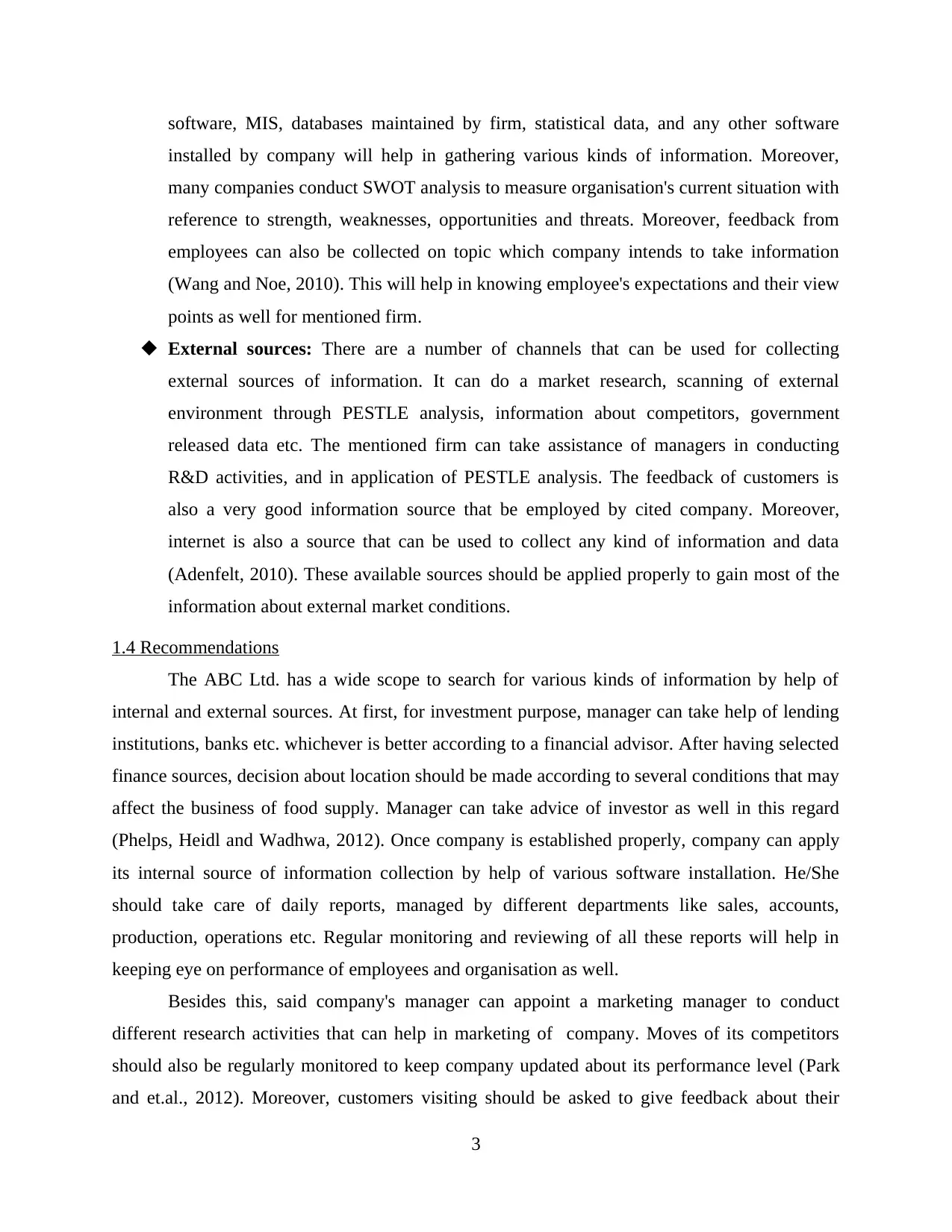
software, MIS, databases maintained by firm, statistical data, and any other software
installed by company will help in gathering various kinds of information. Moreover,
many companies conduct SWOT analysis to measure organisation's current situation with
reference to strength, weaknesses, opportunities and threats. Moreover, feedback from
employees can also be collected on topic which company intends to take information
(Wang and Noe, 2010). This will help in knowing employee's expectations and their view
points as well for mentioned firm.
External sources: There are a number of channels that can be used for collecting
external sources of information. It can do a market research, scanning of external
environment through PESTLE analysis, information about competitors, government
released data etc. The mentioned firm can take assistance of managers in conducting
R&D activities, and in application of PESTLE analysis. The feedback of customers is
also a very good information source that be employed by cited company. Moreover,
internet is also a source that can be used to collect any kind of information and data
(Adenfelt, 2010). These available sources should be applied properly to gain most of the
information about external market conditions.
1.4 Recommendations
The ABC Ltd. has a wide scope to search for various kinds of information by help of
internal and external sources. At first, for investment purpose, manager can take help of lending
institutions, banks etc. whichever is better according to a financial advisor. After having selected
finance sources, decision about location should be made according to several conditions that may
affect the business of food supply. Manager can take advice of investor as well in this regard
(Phelps, Heidl and Wadhwa, 2012). Once company is established properly, company can apply
its internal source of information collection by help of various software installation. He/She
should take care of daily reports, managed by different departments like sales, accounts,
production, operations etc. Regular monitoring and reviewing of all these reports will help in
keeping eye on performance of employees and organisation as well.
Besides this, said company's manager can appoint a marketing manager to conduct
different research activities that can help in marketing of company. Moves of its competitors
should also be regularly monitored to keep company updated about its performance level (Park
and et.al., 2012). Moreover, customers visiting should be asked to give feedback about their
3
installed by company will help in gathering various kinds of information. Moreover,
many companies conduct SWOT analysis to measure organisation's current situation with
reference to strength, weaknesses, opportunities and threats. Moreover, feedback from
employees can also be collected on topic which company intends to take information
(Wang and Noe, 2010). This will help in knowing employee's expectations and their view
points as well for mentioned firm.
External sources: There are a number of channels that can be used for collecting
external sources of information. It can do a market research, scanning of external
environment through PESTLE analysis, information about competitors, government
released data etc. The mentioned firm can take assistance of managers in conducting
R&D activities, and in application of PESTLE analysis. The feedback of customers is
also a very good information source that be employed by cited company. Moreover,
internet is also a source that can be used to collect any kind of information and data
(Adenfelt, 2010). These available sources should be applied properly to gain most of the
information about external market conditions.
1.4 Recommendations
The ABC Ltd. has a wide scope to search for various kinds of information by help of
internal and external sources. At first, for investment purpose, manager can take help of lending
institutions, banks etc. whichever is better according to a financial advisor. After having selected
finance sources, decision about location should be made according to several conditions that may
affect the business of food supply. Manager can take advice of investor as well in this regard
(Phelps, Heidl and Wadhwa, 2012). Once company is established properly, company can apply
its internal source of information collection by help of various software installation. He/She
should take care of daily reports, managed by different departments like sales, accounts,
production, operations etc. Regular monitoring and reviewing of all these reports will help in
keeping eye on performance of employees and organisation as well.
Besides this, said company's manager can appoint a marketing manager to conduct
different research activities that can help in marketing of company. Moves of its competitors
should also be regularly monitored to keep company updated about its performance level (Park
and et.al., 2012). Moreover, customers visiting should be asked to give feedback about their
3
⊘ This is a preview!⊘
Do you want full access?
Subscribe today to unlock all pages.

Trusted by 1+ million students worldwide
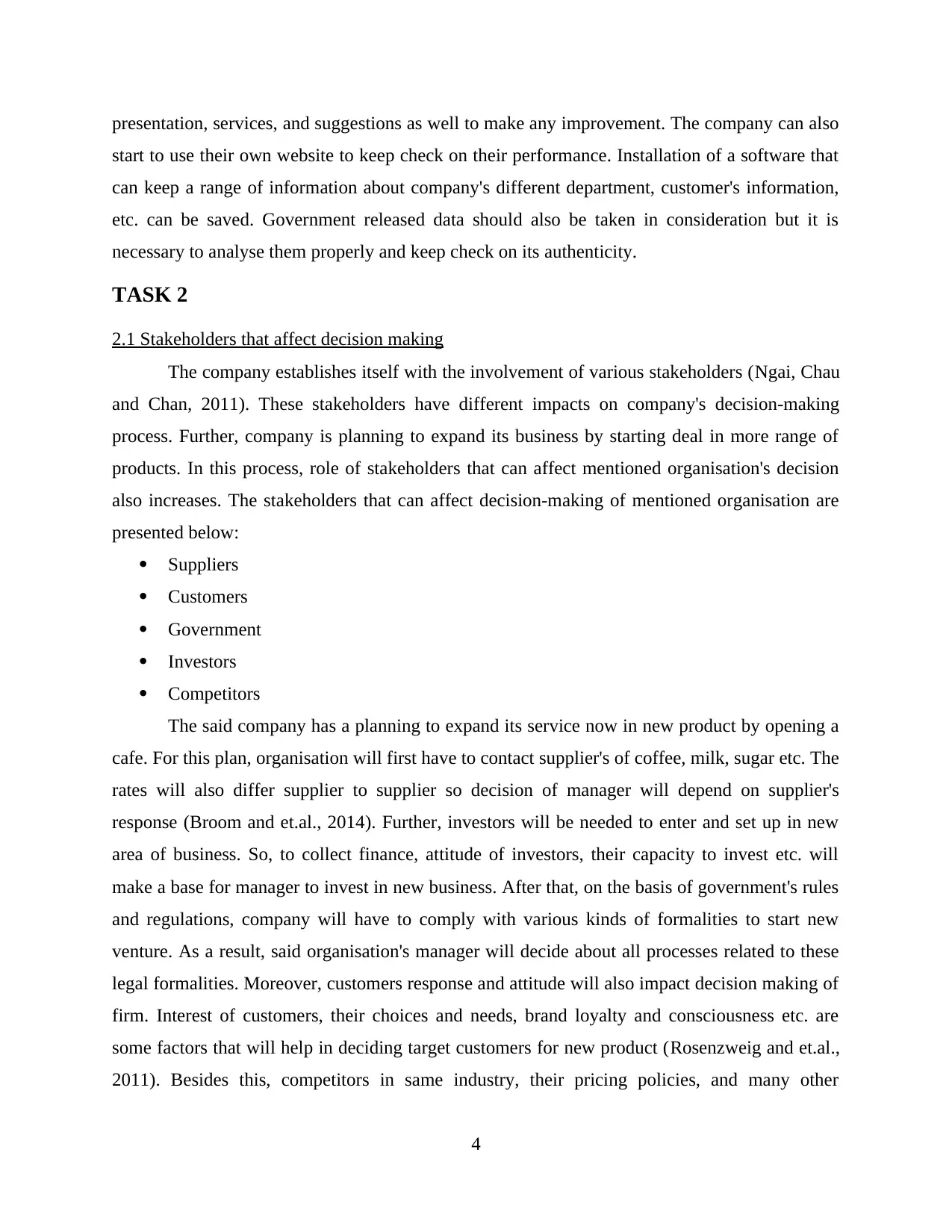
presentation, services, and suggestions as well to make any improvement. The company can also
start to use their own website to keep check on their performance. Installation of a software that
can keep a range of information about company's different department, customer's information,
etc. can be saved. Government released data should also be taken in consideration but it is
necessary to analyse them properly and keep check on its authenticity.
TASK 2
2.1 Stakeholders that affect decision making
The company establishes itself with the involvement of various stakeholders (Ngai, Chau
and Chan, 2011). These stakeholders have different impacts on company's decision-making
process. Further, company is planning to expand its business by starting deal in more range of
products. In this process, role of stakeholders that can affect mentioned organisation's decision
also increases. The stakeholders that can affect decision-making of mentioned organisation are
presented below:
Suppliers
Customers
Government
Investors
Competitors
The said company has a planning to expand its service now in new product by opening a
cafe. For this plan, organisation will first have to contact supplier's of coffee, milk, sugar etc. The
rates will also differ supplier to supplier so decision of manager will depend on supplier's
response (Broom and et.al., 2014). Further, investors will be needed to enter and set up in new
area of business. So, to collect finance, attitude of investors, their capacity to invest etc. will
make a base for manager to invest in new business. After that, on the basis of government's rules
and regulations, company will have to comply with various kinds of formalities to start new
venture. As a result, said organisation's manager will decide about all processes related to these
legal formalities. Moreover, customers response and attitude will also impact decision making of
firm. Interest of customers, their choices and needs, brand loyalty and consciousness etc. are
some factors that will help in deciding target customers for new product (Rosenzweig and et.al.,
2011). Besides this, competitors in same industry, their pricing policies, and many other
4
start to use their own website to keep check on their performance. Installation of a software that
can keep a range of information about company's different department, customer's information,
etc. can be saved. Government released data should also be taken in consideration but it is
necessary to analyse them properly and keep check on its authenticity.
TASK 2
2.1 Stakeholders that affect decision making
The company establishes itself with the involvement of various stakeholders (Ngai, Chau
and Chan, 2011). These stakeholders have different impacts on company's decision-making
process. Further, company is planning to expand its business by starting deal in more range of
products. In this process, role of stakeholders that can affect mentioned organisation's decision
also increases. The stakeholders that can affect decision-making of mentioned organisation are
presented below:
Suppliers
Customers
Government
Investors
Competitors
The said company has a planning to expand its service now in new product by opening a
cafe. For this plan, organisation will first have to contact supplier's of coffee, milk, sugar etc. The
rates will also differ supplier to supplier so decision of manager will depend on supplier's
response (Broom and et.al., 2014). Further, investors will be needed to enter and set up in new
area of business. So, to collect finance, attitude of investors, their capacity to invest etc. will
make a base for manager to invest in new business. After that, on the basis of government's rules
and regulations, company will have to comply with various kinds of formalities to start new
venture. As a result, said organisation's manager will decide about all processes related to these
legal formalities. Moreover, customers response and attitude will also impact decision making of
firm. Interest of customers, their choices and needs, brand loyalty and consciousness etc. are
some factors that will help in deciding target customers for new product (Rosenzweig and et.al.,
2011). Besides this, competitors in same industry, their pricing policies, and many other
4
Paraphrase This Document
Need a fresh take? Get an instant paraphrase of this document with our AI Paraphraser
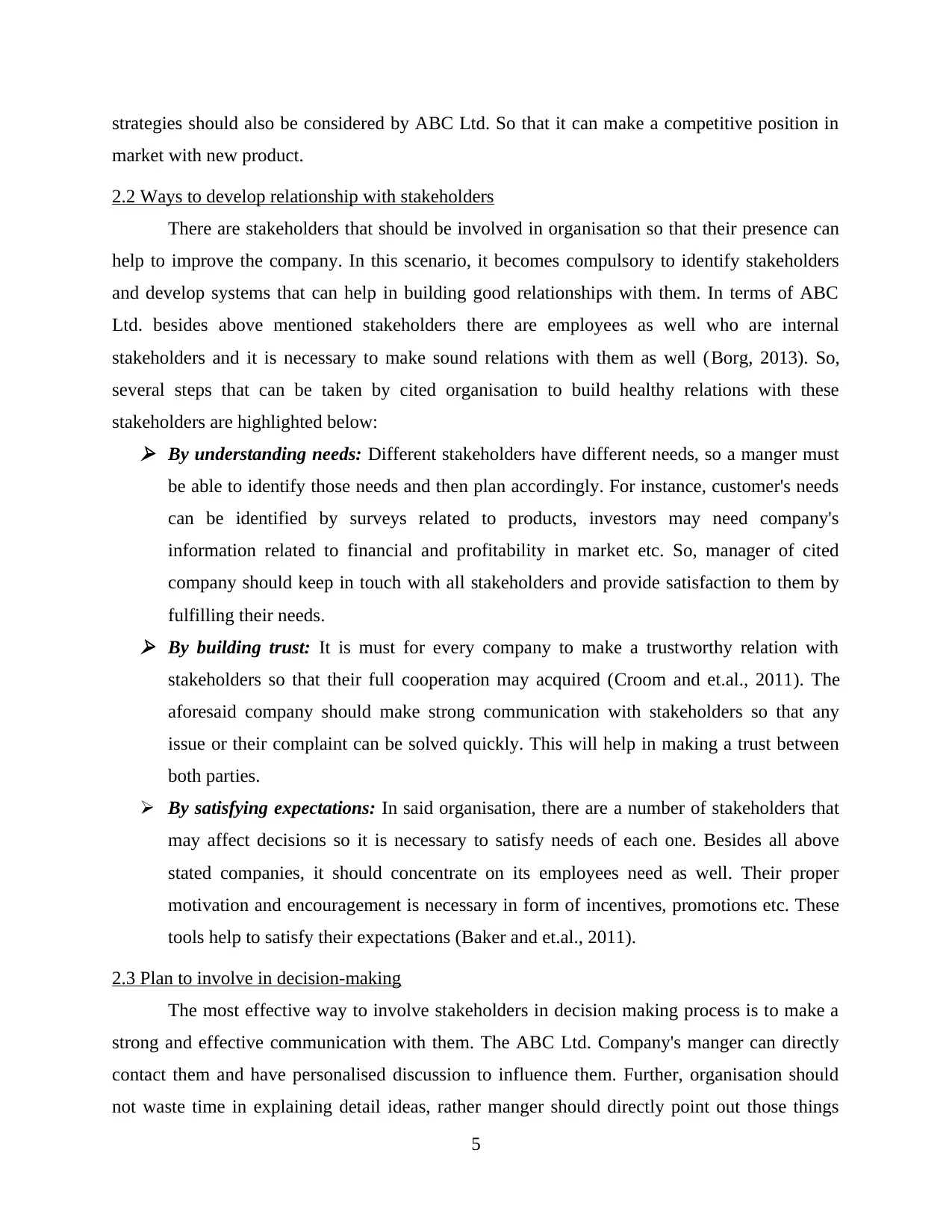
strategies should also be considered by ABC Ltd. So that it can make a competitive position in
market with new product.
2.2 Ways to develop relationship with stakeholders
There are stakeholders that should be involved in organisation so that their presence can
help to improve the company. In this scenario, it becomes compulsory to identify stakeholders
and develop systems that can help in building good relationships with them. In terms of ABC
Ltd. besides above mentioned stakeholders there are employees as well who are internal
stakeholders and it is necessary to make sound relations with them as well (Borg, 2013). So,
several steps that can be taken by cited organisation to build healthy relations with these
stakeholders are highlighted below: By understanding needs: Different stakeholders have different needs, so a manger must
be able to identify those needs and then plan accordingly. For instance, customer's needs
can be identified by surveys related to products, investors may need company's
information related to financial and profitability in market etc. So, manager of cited
company should keep in touch with all stakeholders and provide satisfaction to them by
fulfilling their needs. By building trust: It is must for every company to make a trustworthy relation with
stakeholders so that their full cooperation may acquired (Croom and et.al., 2011). The
aforesaid company should make strong communication with stakeholders so that any
issue or their complaint can be solved quickly. This will help in making a trust between
both parties.
By satisfying expectations: In said organisation, there are a number of stakeholders that
may affect decisions so it is necessary to satisfy needs of each one. Besides all above
stated companies, it should concentrate on its employees need as well. Their proper
motivation and encouragement is necessary in form of incentives, promotions etc. These
tools help to satisfy their expectations (Baker and et.al., 2011).
2.3 Plan to involve in decision-making
The most effective way to involve stakeholders in decision making process is to make a
strong and effective communication with them. The ABC Ltd. Company's manger can directly
contact them and have personalised discussion to influence them. Further, organisation should
not waste time in explaining detail ideas, rather manger should directly point out those things
5
market with new product.
2.2 Ways to develop relationship with stakeholders
There are stakeholders that should be involved in organisation so that their presence can
help to improve the company. In this scenario, it becomes compulsory to identify stakeholders
and develop systems that can help in building good relationships with them. In terms of ABC
Ltd. besides above mentioned stakeholders there are employees as well who are internal
stakeholders and it is necessary to make sound relations with them as well (Borg, 2013). So,
several steps that can be taken by cited organisation to build healthy relations with these
stakeholders are highlighted below: By understanding needs: Different stakeholders have different needs, so a manger must
be able to identify those needs and then plan accordingly. For instance, customer's needs
can be identified by surveys related to products, investors may need company's
information related to financial and profitability in market etc. So, manager of cited
company should keep in touch with all stakeholders and provide satisfaction to them by
fulfilling their needs. By building trust: It is must for every company to make a trustworthy relation with
stakeholders so that their full cooperation may acquired (Croom and et.al., 2011). The
aforesaid company should make strong communication with stakeholders so that any
issue or their complaint can be solved quickly. This will help in making a trust between
both parties.
By satisfying expectations: In said organisation, there are a number of stakeholders that
may affect decisions so it is necessary to satisfy needs of each one. Besides all above
stated companies, it should concentrate on its employees need as well. Their proper
motivation and encouragement is necessary in form of incentives, promotions etc. These
tools help to satisfy their expectations (Baker and et.al., 2011).
2.3 Plan to involve in decision-making
The most effective way to involve stakeholders in decision making process is to make a
strong and effective communication with them. The ABC Ltd. Company's manger can directly
contact them and have personalised discussion to influence them. Further, organisation should
not waste time in explaining detail ideas, rather manger should directly point out those things
5
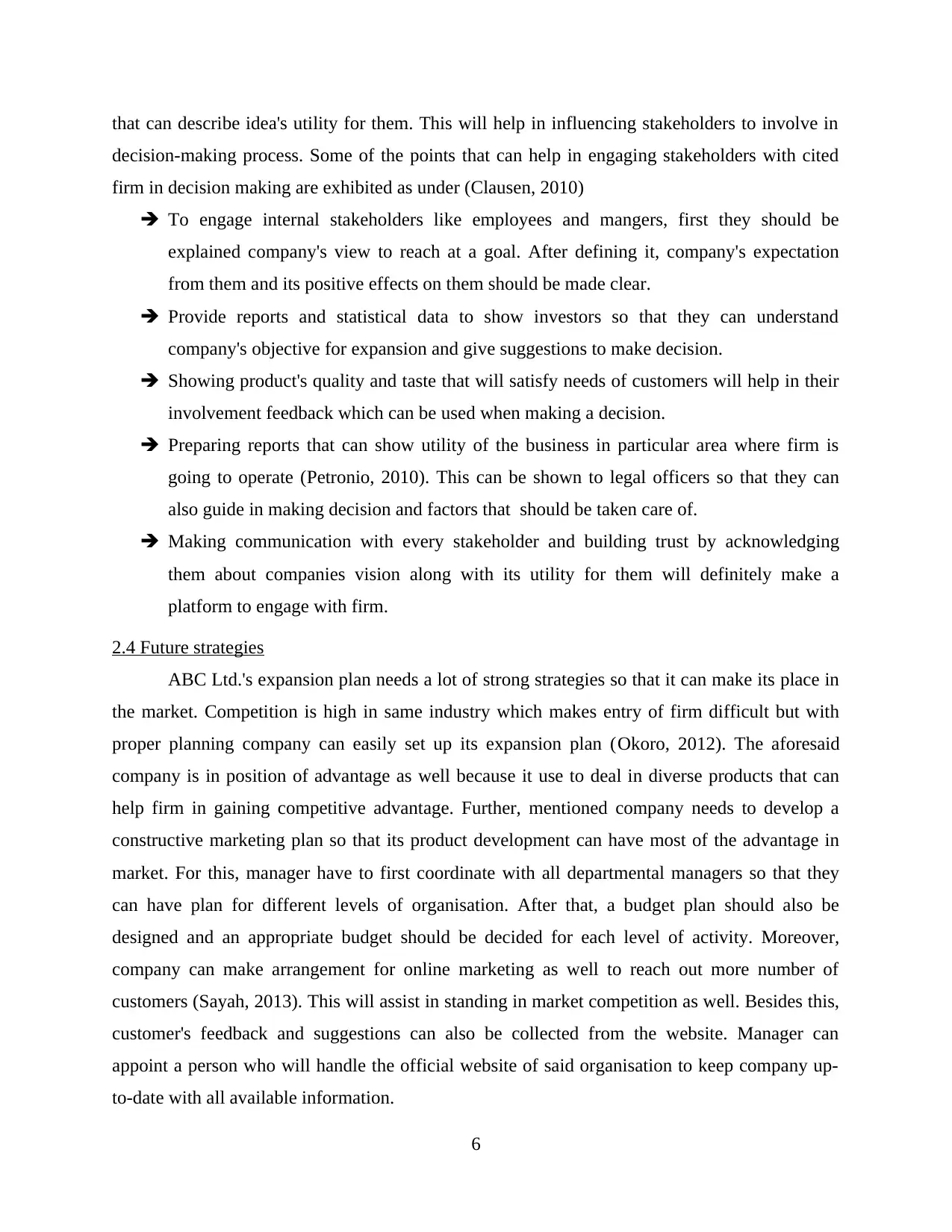
that can describe idea's utility for them. This will help in influencing stakeholders to involve in
decision-making process. Some of the points that can help in engaging stakeholders with cited
firm in decision making are exhibited as under (Clausen, 2010)
To engage internal stakeholders like employees and mangers, first they should be
explained company's view to reach at a goal. After defining it, company's expectation
from them and its positive effects on them should be made clear.
Provide reports and statistical data to show investors so that they can understand
company's objective for expansion and give suggestions to make decision.
Showing product's quality and taste that will satisfy needs of customers will help in their
involvement feedback which can be used when making a decision.
Preparing reports that can show utility of the business in particular area where firm is
going to operate (Petronio, 2010). This can be shown to legal officers so that they can
also guide in making decision and factors that should be taken care of.
Making communication with every stakeholder and building trust by acknowledging
them about companies vision along with its utility for them will definitely make a
platform to engage with firm.
2.4 Future strategies
ABC Ltd.'s expansion plan needs a lot of strong strategies so that it can make its place in
the market. Competition is high in same industry which makes entry of firm difficult but with
proper planning company can easily set up its expansion plan (Okoro, 2012). The aforesaid
company is in position of advantage as well because it use to deal in diverse products that can
help firm in gaining competitive advantage. Further, mentioned company needs to develop a
constructive marketing plan so that its product development can have most of the advantage in
market. For this, manager have to first coordinate with all departmental managers so that they
can have plan for different levels of organisation. After that, a budget plan should also be
designed and an appropriate budget should be decided for each level of activity. Moreover,
company can make arrangement for online marketing as well to reach out more number of
customers (Sayah, 2013). This will assist in standing in market competition as well. Besides this,
customer's feedback and suggestions can also be collected from the website. Manager can
appoint a person who will handle the official website of said organisation to keep company up-
to-date with all available information.
6
decision-making process. Some of the points that can help in engaging stakeholders with cited
firm in decision making are exhibited as under (Clausen, 2010)
To engage internal stakeholders like employees and mangers, first they should be
explained company's view to reach at a goal. After defining it, company's expectation
from them and its positive effects on them should be made clear.
Provide reports and statistical data to show investors so that they can understand
company's objective for expansion and give suggestions to make decision.
Showing product's quality and taste that will satisfy needs of customers will help in their
involvement feedback which can be used when making a decision.
Preparing reports that can show utility of the business in particular area where firm is
going to operate (Petronio, 2010). This can be shown to legal officers so that they can
also guide in making decision and factors that should be taken care of.
Making communication with every stakeholder and building trust by acknowledging
them about companies vision along with its utility for them will definitely make a
platform to engage with firm.
2.4 Future strategies
ABC Ltd.'s expansion plan needs a lot of strong strategies so that it can make its place in
the market. Competition is high in same industry which makes entry of firm difficult but with
proper planning company can easily set up its expansion plan (Okoro, 2012). The aforesaid
company is in position of advantage as well because it use to deal in diverse products that can
help firm in gaining competitive advantage. Further, mentioned company needs to develop a
constructive marketing plan so that its product development can have most of the advantage in
market. For this, manager have to first coordinate with all departmental managers so that they
can have plan for different levels of organisation. After that, a budget plan should also be
designed and an appropriate budget should be decided for each level of activity. Moreover,
company can make arrangement for online marketing as well to reach out more number of
customers (Sayah, 2013). This will assist in standing in market competition as well. Besides this,
customer's feedback and suggestions can also be collected from the website. Manager can
appoint a person who will handle the official website of said organisation to keep company up-
to-date with all available information.
6
⊘ This is a preview!⊘
Do you want full access?
Subscribe today to unlock all pages.

Trusted by 1+ million students worldwide
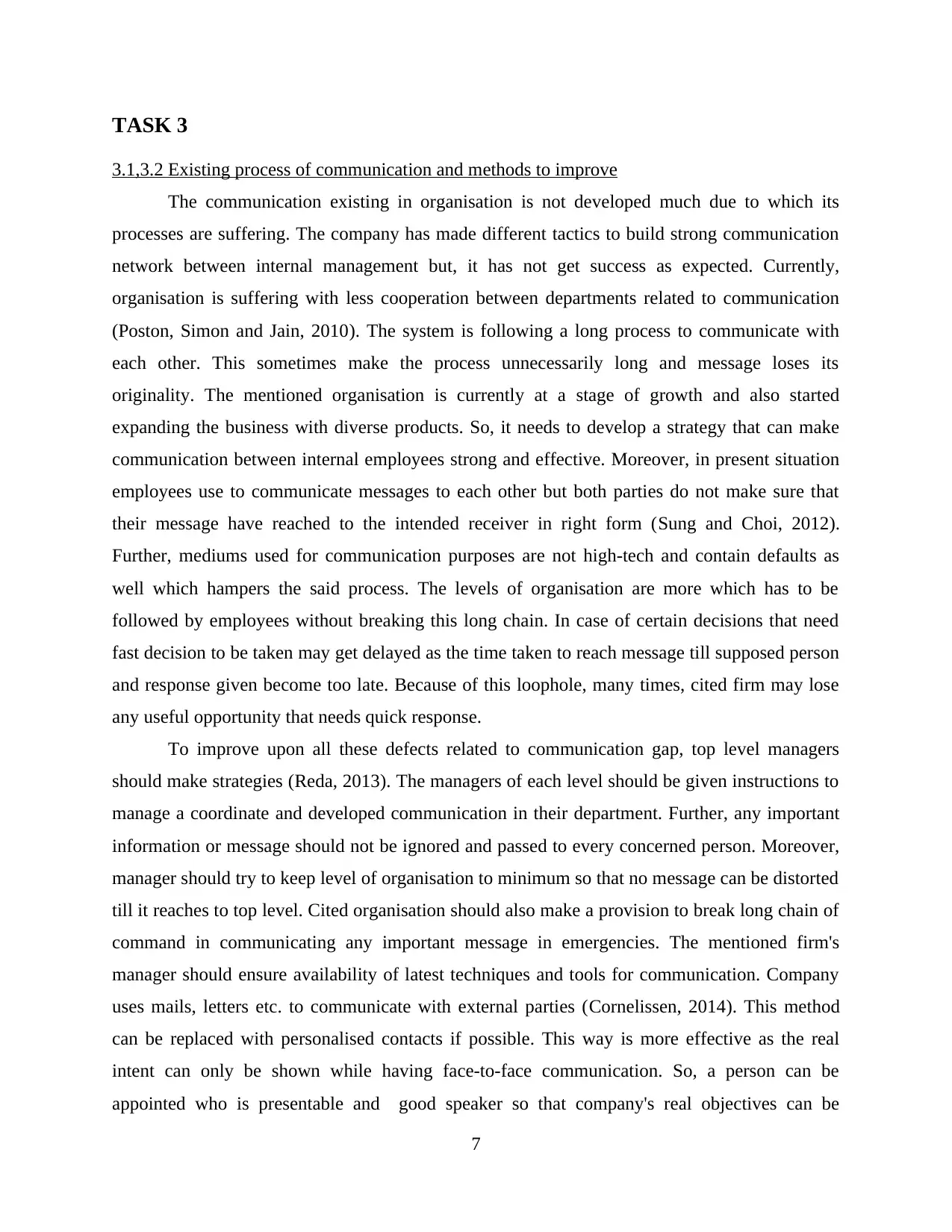
TASK 3
3.1,3.2 Existing process of communication and methods to improve
The communication existing in organisation is not developed much due to which its
processes are suffering. The company has made different tactics to build strong communication
network between internal management but, it has not get success as expected. Currently,
organisation is suffering with less cooperation between departments related to communication
(Poston, Simon and Jain, 2010). The system is following a long process to communicate with
each other. This sometimes make the process unnecessarily long and message loses its
originality. The mentioned organisation is currently at a stage of growth and also started
expanding the business with diverse products. So, it needs to develop a strategy that can make
communication between internal employees strong and effective. Moreover, in present situation
employees use to communicate messages to each other but both parties do not make sure that
their message have reached to the intended receiver in right form (Sung and Choi, 2012).
Further, mediums used for communication purposes are not high-tech and contain defaults as
well which hampers the said process. The levels of organisation are more which has to be
followed by employees without breaking this long chain. In case of certain decisions that need
fast decision to be taken may get delayed as the time taken to reach message till supposed person
and response given become too late. Because of this loophole, many times, cited firm may lose
any useful opportunity that needs quick response.
To improve upon all these defects related to communication gap, top level managers
should make strategies (Reda, 2013). The managers of each level should be given instructions to
manage a coordinate and developed communication in their department. Further, any important
information or message should not be ignored and passed to every concerned person. Moreover,
manager should try to keep level of organisation to minimum so that no message can be distorted
till it reaches to top level. Cited organisation should also make a provision to break long chain of
command in communicating any important message in emergencies. The mentioned firm's
manager should ensure availability of latest techniques and tools for communication. Company
uses mails, letters etc. to communicate with external parties (Cornelissen, 2014). This method
can be replaced with personalised contacts if possible. This way is more effective as the real
intent can only be shown while having face-to-face communication. So, a person can be
appointed who is presentable and good speaker so that company's real objectives can be
7
3.1,3.2 Existing process of communication and methods to improve
The communication existing in organisation is not developed much due to which its
processes are suffering. The company has made different tactics to build strong communication
network between internal management but, it has not get success as expected. Currently,
organisation is suffering with less cooperation between departments related to communication
(Poston, Simon and Jain, 2010). The system is following a long process to communicate with
each other. This sometimes make the process unnecessarily long and message loses its
originality. The mentioned organisation is currently at a stage of growth and also started
expanding the business with diverse products. So, it needs to develop a strategy that can make
communication between internal employees strong and effective. Moreover, in present situation
employees use to communicate messages to each other but both parties do not make sure that
their message have reached to the intended receiver in right form (Sung and Choi, 2012).
Further, mediums used for communication purposes are not high-tech and contain defaults as
well which hampers the said process. The levels of organisation are more which has to be
followed by employees without breaking this long chain. In case of certain decisions that need
fast decision to be taken may get delayed as the time taken to reach message till supposed person
and response given become too late. Because of this loophole, many times, cited firm may lose
any useful opportunity that needs quick response.
To improve upon all these defects related to communication gap, top level managers
should make strategies (Reda, 2013). The managers of each level should be given instructions to
manage a coordinate and developed communication in their department. Further, any important
information or message should not be ignored and passed to every concerned person. Moreover,
manager should try to keep level of organisation to minimum so that no message can be distorted
till it reaches to top level. Cited organisation should also make a provision to break long chain of
command in communicating any important message in emergencies. The mentioned firm's
manager should ensure availability of latest techniques and tools for communication. Company
uses mails, letters etc. to communicate with external parties (Cornelissen, 2014). This method
can be replaced with personalised contacts if possible. This way is more effective as the real
intent can only be shown while having face-to-face communication. So, a person can be
appointed who is presentable and good speaker so that company's real objectives can be
7
Paraphrase This Document
Need a fresh take? Get an instant paraphrase of this document with our AI Paraphraser
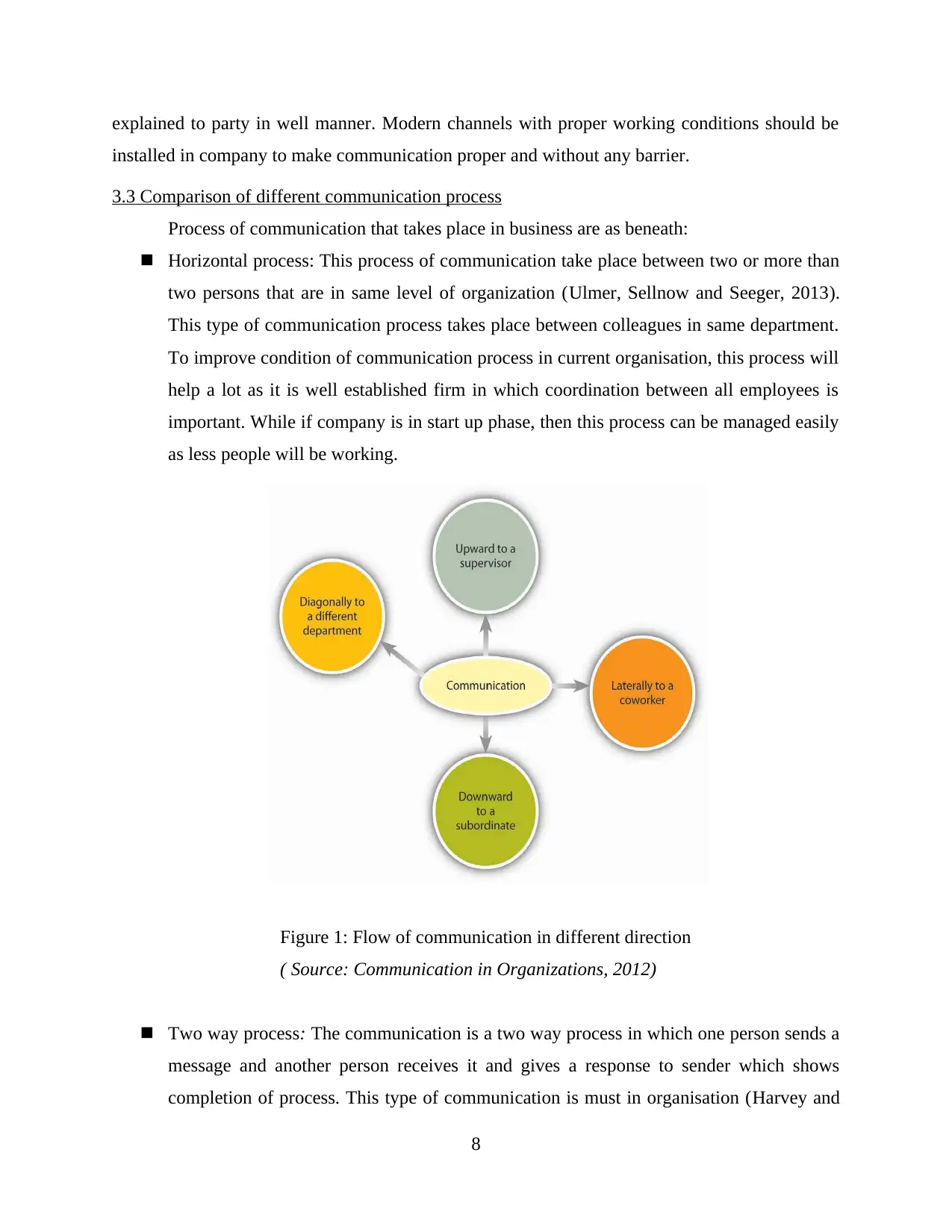
explained to party in well manner. Modern channels with proper working conditions should be
installed in company to make communication proper and without any barrier.
3.3 Comparison of different communication process
Process of communication that takes place in business are as beneath:
Horizontal process: This process of communication take place between two or more than
two persons that are in same level of organization (Ulmer, Sellnow and Seeger, 2013).
This type of communication process takes place between colleagues in same department.
To improve condition of communication process in current organisation, this process will
help a lot as it is well established firm in which coordination between all employees is
important. While if company is in start up phase, then this process can be managed easily
as less people will be working.
Figure 1: Flow of communication in different direction
( Source: Communication in Organizations, 2012)
Two way process: The communication is a two way process in which one person sends a
message and another person receives it and gives a response to sender which shows
completion of process. This type of communication is must in organisation (Harvey and
8
installed in company to make communication proper and without any barrier.
3.3 Comparison of different communication process
Process of communication that takes place in business are as beneath:
Horizontal process: This process of communication take place between two or more than
two persons that are in same level of organization (Ulmer, Sellnow and Seeger, 2013).
This type of communication process takes place between colleagues in same department.
To improve condition of communication process in current organisation, this process will
help a lot as it is well established firm in which coordination between all employees is
important. While if company is in start up phase, then this process can be managed easily
as less people will be working.
Figure 1: Flow of communication in different direction
( Source: Communication in Organizations, 2012)
Two way process: The communication is a two way process in which one person sends a
message and another person receives it and gives a response to sender which shows
completion of process. This type of communication is must in organisation (Harvey and
8
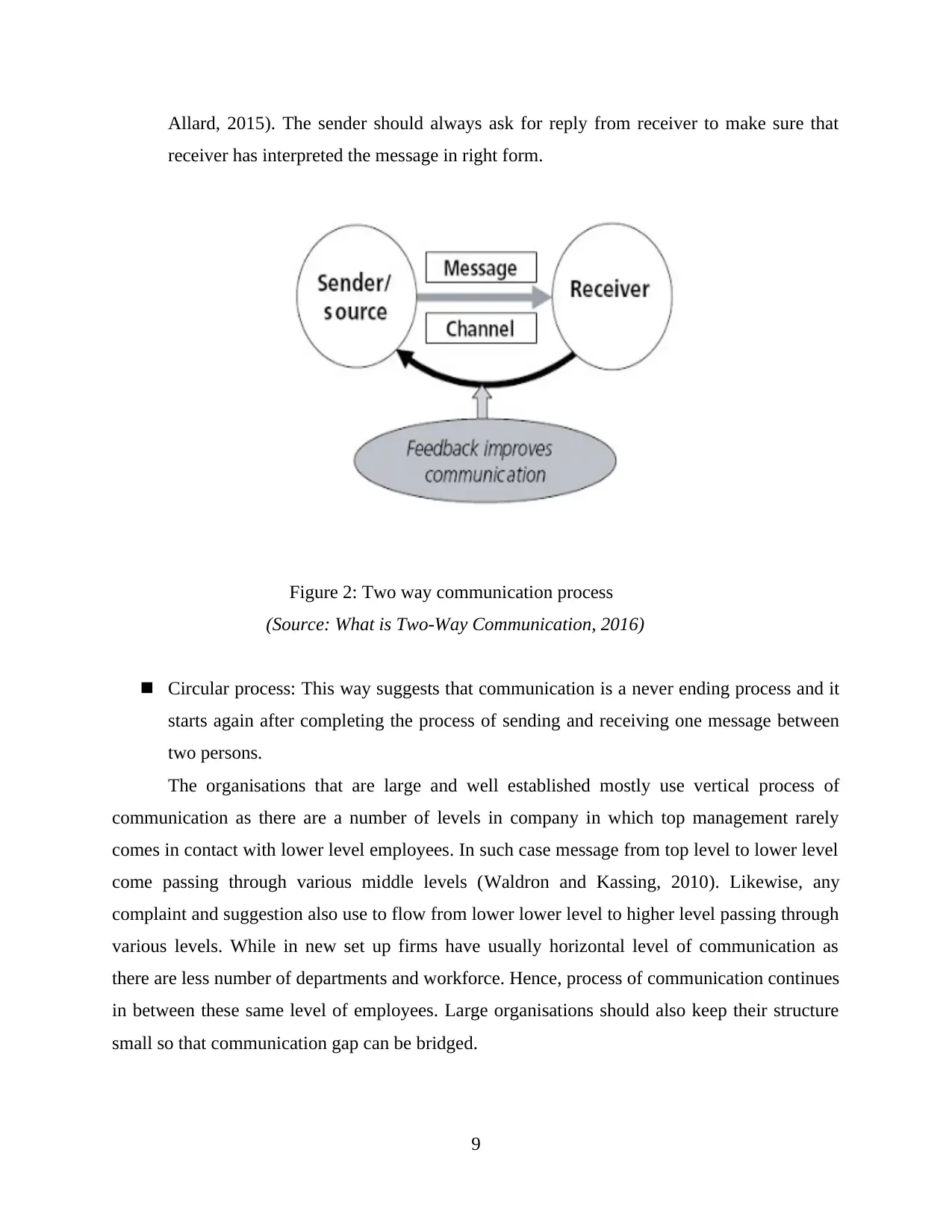
Allard, 2015). The sender should always ask for reply from receiver to make sure that
receiver has interpreted the message in right form.
Figure 2: Two way communication process
(Source: What is Two-Way Communication, 2016)
Circular process: This way suggests that communication is a never ending process and it
starts again after completing the process of sending and receiving one message between
two persons.
The organisations that are large and well established mostly use vertical process of
communication as there are a number of levels in company in which top management rarely
comes in contact with lower level employees. In such case message from top level to lower level
come passing through various middle levels (Waldron and Kassing, 2010). Likewise, any
complaint and suggestion also use to flow from lower lower level to higher level passing through
various levels. While in new set up firms have usually horizontal level of communication as
there are less number of departments and workforce. Hence, process of communication continues
in between these same level of employees. Large organisations should also keep their structure
small so that communication gap can be bridged.
9
receiver has interpreted the message in right form.
Figure 2: Two way communication process
(Source: What is Two-Way Communication, 2016)
Circular process: This way suggests that communication is a never ending process and it
starts again after completing the process of sending and receiving one message between
two persons.
The organisations that are large and well established mostly use vertical process of
communication as there are a number of levels in company in which top management rarely
comes in contact with lower level employees. In such case message from top level to lower level
come passing through various middle levels (Waldron and Kassing, 2010). Likewise, any
complaint and suggestion also use to flow from lower lower level to higher level passing through
various levels. While in new set up firms have usually horizontal level of communication as
there are less number of departments and workforce. Hence, process of communication continues
in between these same level of employees. Large organisations should also keep their structure
small so that communication gap can be bridged.
9
⊘ This is a preview!⊘
Do you want full access?
Subscribe today to unlock all pages.

Trusted by 1+ million students worldwide
1 out of 17
Related Documents
Your All-in-One AI-Powered Toolkit for Academic Success.
+13062052269
info@desklib.com
Available 24*7 on WhatsApp / Email
![[object Object]](/_next/static/media/star-bottom.7253800d.svg)
Unlock your academic potential
Copyright © 2020–2025 A2Z Services. All Rights Reserved. Developed and managed by ZUCOL.





